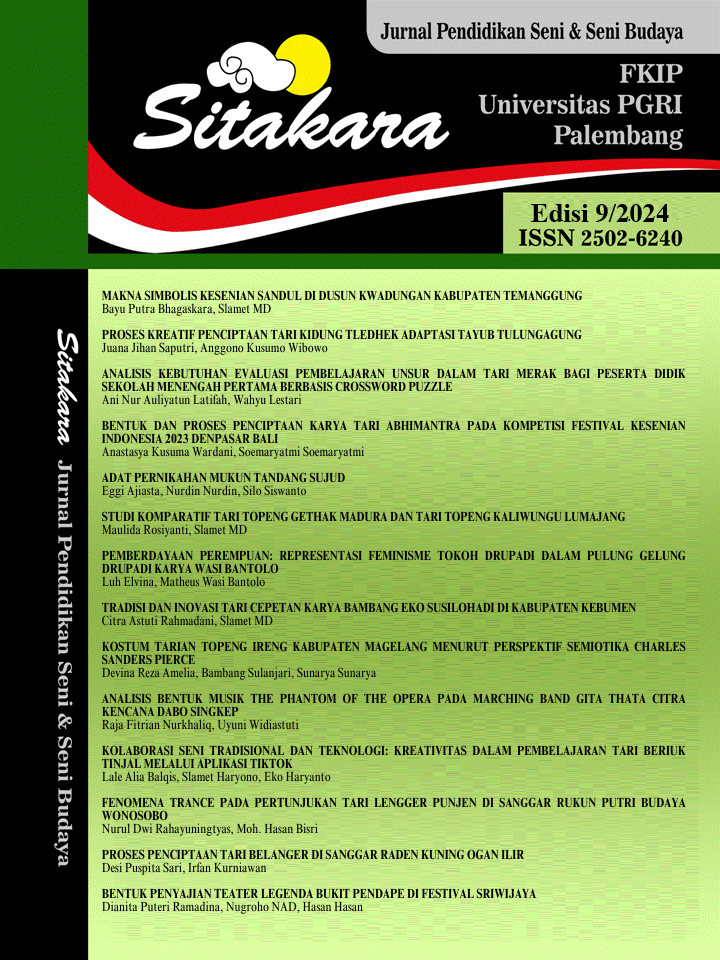Analisis Bentuk Musik The Phantom of The Opera Pada Marching Band Gita Thata Citra Kencana Dabo Singkep
DOI:
https://doi.org/10.31851/sitakara.v9i2.16221Abstract
Penelitian bertujuan untuk mendeskripsikan: 1) Eksistensi Marching Band Gita Thata Citra Kencana Dabo Singkep. 2) Bentuk musik pada lagu The Phantom of The Opera pada Marching Band Gita Thata Citra Kencana Dabo Singkep. Masalah difokuskan pada eksistensi dan bentuk musik. Guna mendekati masalah ini dipergunakan acuan teori eksistensi dan teori bentuk musik (prier). Metode penelitian yang digunakan dalam penelitian ini adalah metode penelitian deskriptif kualitatif. Data-data dikumpulkan melalui observasi, wawancara, dokumentasi dan kerja laboratorium dan dianalisis secara mendalam dan detail sesuai dengan teori yang digunakan. Kajian ini menyimpulkan bahwa 1) Marching Band Gita Thata Citra Kencana hingga saat ini masih eksis dikalangan masyarakat Dabo Singkep, 2) bentuk musik yang terdapat pada aransemen The Phantom of The Opera memuat 5 motif asli dengan 4 motif pengembangan, 3 kalimat depan atau antesenden dan 3 kalimat belakang atau konsekwen, yaitu (ax), (by) dan (cz). Aransemen ini adalah bentuk lagu tiga bagian, yaitu A(ax), B(by) dan C(ax).
Kata Kunci: Analisis; The Phantom of The Opera; Marching Band; Dabo Singkep; Eksistensi.
References
Arief, Aqilla Sekar Febrianti, Dkk. (2022). Eksistensi Grup Drum Band Cipasung di Desa Cipakat
Kecamatan Singaparna Kabupaten Tasikmalaya. Jurnal Pendidikan Seni, Vol.5, (No. 2). Hal. 283-288.
Banoe, Pono. (2007). Kamus Musik. Yogyakarta: Kanisius.
Gallagher, T. (2019). Historical Trace Paper-Marching Bands and College Recruitment and Retention.
Jannah, Billawa Gatra. (2021). Lagu “Fire Dance” Karya Jeson Pub Aransemen Momon Maryono (Tinjauan Aransemen Marching Band). Repertoar Journal, Vol. 1 (No.2). Hal. 202-211.
Harahap, Ahmad Bengar. (2012). Selayang Pandang Seni Marching Band. Digilib Repository.
Herawati, Ika Prawita. (2017). Eksistensi Kesenian Jepin Di Dusun Bandungan Desa Darmayasa
Kecamatan Pejawaran Kabupaten Banjarnegara. Jurnal Joged, Vol. 9 (No. 1). Hal. 441-456.
Jaya, I. M. L. M. J. (2021). Metode Penelitian Kuantitatif dan Kualitatif. Yogyakarta: Quadrant.
Kirnadi. (2011). Dunia Marching Band. Jakarta : PT Citra Intirama.
Mahdy, D.A. (2021). Analisis Bentuk Musik dan Teknik Permainan Piano Traumerei Ftom Kinderszenen
Op.15: No.7 In F Major. Robert Schumann. Repertoar Journal, Vol. 2, (No. 1), Hal. 92-101.
Mukhlis, Dkk. (2019). Creation And Performance of Marching Band Based On Ethnic Diversity In North Sumatera. International Journal of Education, Learning and Development, Vol. 7 (No. 2), Hal. 20-36.
Pamadhi, Hadjar, Dkk. (2022). Pendidikan Seni di SD. Tangerang Selatan: Universitas Terbuka.
Paz, Farhan Reza. (2015). Analisis Musik Medley “The The Phantom of The Opera” Untuk Paduan Suara Karya Andrew Lloyd Webber Aransemen Ed Lojeski. Upi Repository.
Prier,K-E. (2020). Ilmu Bentuk Musik. Yogyakarta: Pusat Liturgi Musik.
Sembiring, Widiastuti, Tarigan. (2020). Keteng-Keteng Development of Three Bamboo Sections. Britain
International of Humanities and Social Sciences (BIoHS) Journal, Vol. 2 (No. 3), Hal 698-705.
Sjafirah, N. A., & Prasanti, D. (2016). Penggunaan Media Komunikasi Dalam Eksistensi Budaya Lokal
Bagi Komunitas Tanah Aksara Studi Deskriptif Kualitatif Tentang Penggunaan Media Komunikasi Dalam Eksistensi Budaya Lokal Bagi Komunitas Tanah Aksara Di Bandung. In Jurnal Ilmu Politik dan Komunikasi, Vol. 6 (No. 2). Hal. 39-50.
Smith, Gary E. (2016). The System Marching Band Methods. GIA Publications: Chicago.
Sugiyono. (2021). Metode Penelitian: Kuantitatif Kualitatif dan R&D. Bandung: Alfabeta.
Suroso, Panji, Dkk. (2019). Dasar-Dasar Analisis Musik. Medan: CV. Kencana Emas Sejahtera.
Syumaisi, Nabilah, Dkk. (2021). Analisis Struktur Musik Dan Makna Lirik Lagu Tombo Ati-Opick. Jurnal
Pendidikan Seni, Vol. 4 (No.1). Hal. 60-74.
Wisnawa, Ketut. (2020). Seni Musik Tradisional Nusantara. Bali: Nila Cakra.
Sumber Internet:
Downloads
Published
How to Cite
Issue
Section
License
Copyright (c) 2024 Raja Fitrian Nurkhaliq, Uyuni Widiastuti

This work is licensed under a Creative Commons Attribution-ShareAlike 4.0 International License.
1. License
Use of articles will be governed by the Creative Commons Attribution - ShareAlike license as currently displayed on Creative Commons Attribution - ShareAlike 4.0 International License (CC BY-SA)
The author warrants that the article is original, written by stated author(s), has not been published before, contains no unlawful statements, does not infringe the rights of others, is subject to copyright that is vested exclusively in the author and free of any third party rights, and that any necessary written permissions to quote from other sources have been obtained by the author(s).
Jurnal Sitakara's spirit is to disseminate articles published are as free as possible. Under the Creative Commons license, Halaman Olahraga Nusantara permits users to copy, distribute, display, and perform the work. Users will also need to attribute authors and Jurnal Sitakara on distributing works in the journal and other media of publications.
4. Rights of Authors
Authors retain all their rights to the published works, such as (but not limited to) the following rights;
1. Copyright and other proprietary rights relating to the article, such as patent rights,
2. The right to use the substance of the article in own future works, including lectures and books,
3. The right to reproduce the article for own purposes,
4. The right to enter into separate, additional contractual arrangements for the non-exclusive distribution of the article's published version (e.g., post it to an institutional repository or publish it in a book), with an acknowledgment of its initial publication in this journal Sitakara.
5. Co-Authorship
If the article was jointly prepared by more than one author, any authors submitting the manuscript warrants that he/she has been authorized by all co-authors to be agreed on this copyright and license notice (agreement) on their behalf, and agrees to inform his/her co-authors of the terms of this policy. Jurnal Sitakara will not be held liable for anything that may arise due to the author(s) internal dispute. Jurnal Sitakara will only communicate with the corresponding author.
6. Royalties
Being an open accessed journal and disseminating articles for free under the Creative Commons license term mentioned, author(s) aware that Jurnal Sitakara entitles the author(s) to no royalties or other fees.
Sitakara Jurnal oleh http://univpgri-palembang.ac.id/e_jurnal/index.php/sitakara dilisensikan di bawah Lisensi Internasional Creative Commons Attribution-ShareAlike 4.0 .




.png)





















